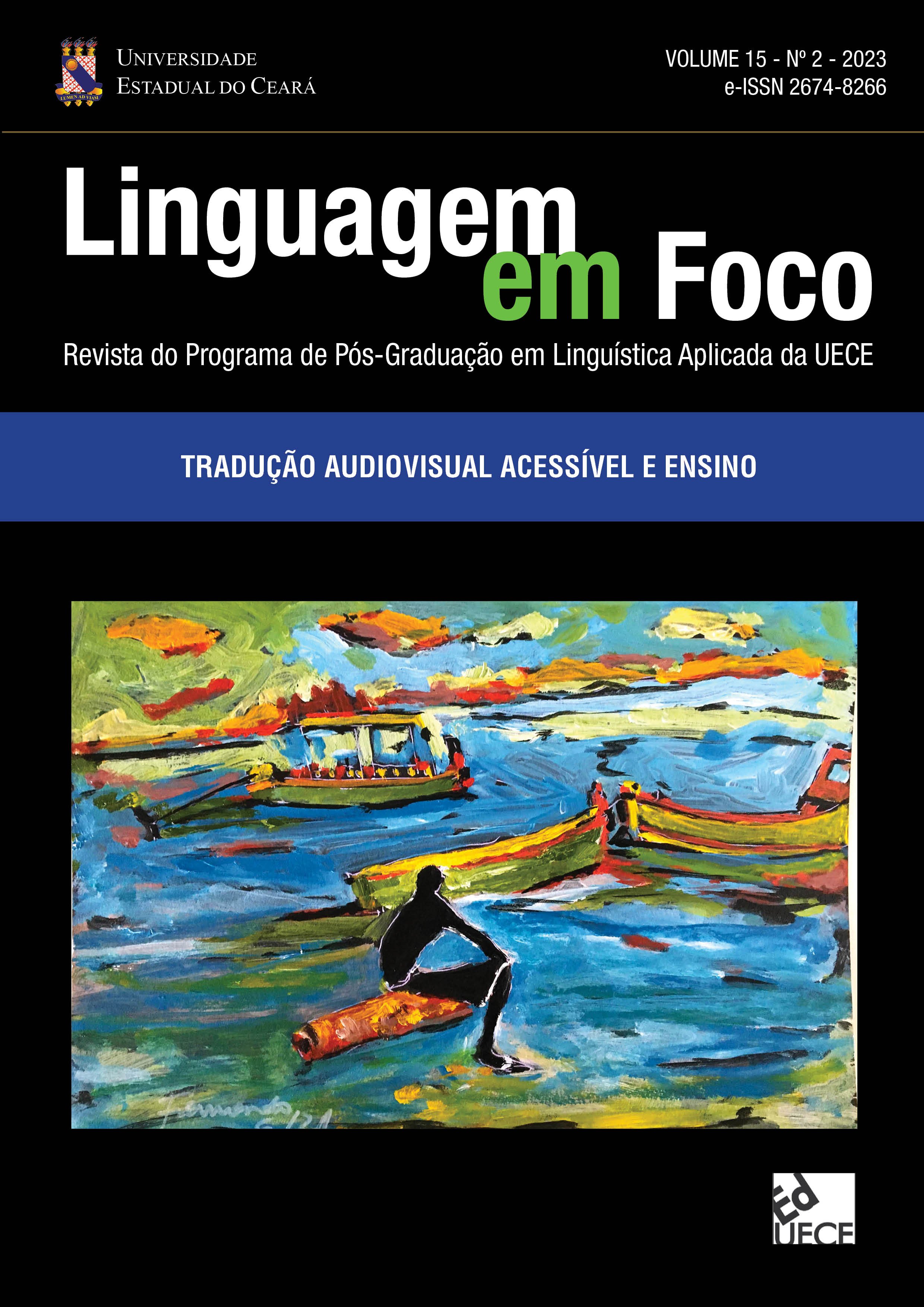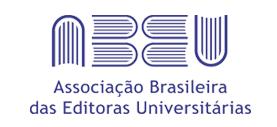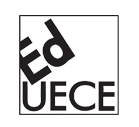A LSE como ferramenta de ensino de Língua Inglesa para surdos
Uma proposta de atividade didática
DOI:
https://doi.org/10.46230/2674-8266-15-10600Palavras-chave:
Tradução Audiovisual, Legendagem para Surdos e Ensurdecidos, Ensino de inglês como língua estrangeira, Aprendizes surdos, LibrasResumo
Estudos experimentais têm comprovado a eficácia do uso da legendagem na aprendizagem de inglês por alunos ouvintes, sendo considerada uma ferramenta que beneficia o processo de aprendizagem das quatro habilidades (leitura, escrita, compreensão e fala). Partimos do pressuposto de que atividades envolvendo a legendagem como ferramenta no aprendizado de línguas estrangeiras podem ser benéficas a aprendizes surdos, tendo em vista que os surdos usuários de línguas visuais são sujeitos cujas identidades se constroem por meio de artefatos visuais e que a Legendagem para Surdos e Ensurdecidos (LSE) tem traduzido efeitos sonoros de forma visual – por meio das legendas. No Brasil, ainda há poucas pesquisas sobre o ensino de línguas estrangeiras para surdos, e não temos conhecimento de documentos oficiais que tratem dessa situação específica (ou seja, do fato de ser não apenas uma LE, mas também uma L3 para o estudante surdo, trazendo, com isso, diversas implicações pedagógicas). O objetivo deste artigo é discutir como a LSE pode contribuir com a aprendizagem do inglês como L3 por surdos, utilizando produções audiovisuais como parte do material didático. Ademais, buscamos, a partir de uma discussão bibliográfica, apresentar uma proposta de atividade didática em que a LSE possa ser utilizada como ferramenta facilitadora da aprendizagem do inglês por surdos usuários da Libras. Nossa intenção é estimular professores de inglês para surdos a utilizar a LSE em suas aulas, buscando promover uma aprendizagem que leve em consideração o aprendiz surdo, usuário de uma língua visuoespacial e com necessidades de aprendizagem que envolvem estratégias visuais.
Downloads
Referências
AMORIM, M. L. C.; SOUZA, F. da F. de; GOMES, A. S. Educação a Distância para Surdos: acessibilidade de plataformas virtuais de aprendizagem. Curitiba: Appris, 2016.
ARAÚJO, V. L. S. O uso de filmes legendados no ensino/aprendizagem de língua inglesa. In: FREITAS, A. C. de; RODRIGUES, L. de O.; SAMPAIO, M. L. P. (Org.). Linguagem, discurso e cultura: múltiplos objetos e abordagens. Mossoró: Queima Bucha, 2008. v. 1. p. 163-177.
BARBOSA, E. R. O uso da tradução audiovisual para o desenvolvimento da compreensão oral em língua espanhola. 2009. 192 f. Dissertação (Mestrado Acadêmico em Linguística Aplicada) – Centro de Humanidades, Universidade Estadual do Ceará, Fortaleza, 2009.
BROWN, H. D. Teaching by principles: an interactive approach to language pedagogy. 2. ed. New York: Longman, 2000.
CARVALHO, F. C. M.; SOUZA, M. C. de; ALVES, O. P. da S.; LEONEL, W. H. dos S. Legendas no processo ensino aprendizagem na educação inclusiva na modalidade a distância. In: CONGRESSO INTERNACIONAL ABED DE EDUCAÇÃO A DISTÂNCIA, 23., 17 a 21 de setembro de 2017, Foz do Iguaçu, Paraná. Anais […]. 2017. DOI: https://doi.org/10.17143/ciaed/XXIIlCIAED.2017.00036
CUNHA. T. M. O uso de filmes legendados no ensino comunicativo de línguas no desenvolvimento da proficiência oral em nível básico de língua estrangeira. 2007. 158 f. Dissertação (Mestrado Acadêmico em Linguística Aplicada) – Centro de Humanidades, Universidade Estadual do Ceará, Fortaleza, 2007.
DÍAZ CINTAS, J.; CRUZ, M. F. Using subtitled video materials for foreign language instruction. In: DÍAZ CINTAS, J. (Org.) The didactics of audiovisual translation. Amsterdam: John Benjamins, 2008. p. 201-214. DOI: https://doi.org/10.1075/btl.77.20dia
FARIA, N. G.; SILVA, D. C. Legendas e janelas: questão de acessibilidade. Revista Sinalizar, v. 1, n. 1, p. 65-77, jan./jun. 2016. DOI: https://doi.org/10.5216/rs.v1i1.36156
FERREIRA, L. Por uma gramática de línguas de sinais. Rio de Janeiro: Tempo Brasileiro, 2010.
GOMES, F. W. B. O uso de filmes legendados como ferramenta para o desenvolvimento da proficiência oral de aprendizes de língua inglesa. 2006. 130 f. Dissertação (Mestrado Acadêmico em Linguística Aplicada) – Centro de Humanidades, Universidade Estadual do Ceará, Fortaleza, 2006.
GOMES, F. W. B. Filmes legendados e ensino de línguas adicionais: um breve panorama sobre as pesquisas do Brasil. Horizontes em Linguística Aplicada, ano 15, n. 1, 2016. Disponível em: http://periodicos.unb.br/index.php/horizontesla/article/viewFile/12244/13987. Acesso em: 15 fev. 2018. DOI: https://doi.org/10.26512/rhla.v15i1.1418
GUARINELLO, A. C. O papel do outro na escrita de sujeitos surdos. São Paulo: Plexus, 2007.
HARVEY, M. S. S. O uso didático do gênero filme legendado na aprendizagem de leitura de textos do gênero jornalístico/noticioso em inglês: um estudo com alunos de uma escola pública de Fortaleza. 2009. 256 f. Dissertação (Mestrado Acadêmico em Linguística Aplicada) – Centro de Humanidades, Universidade Estadual do Ceará, Fortaleza, 2009.
OLIVEIRA FILHO, L. Utilização da legendagem intralinguística no desenvolvimento da proficiência oral em língua francesa. 2008. 133 f. Dissertação (Mestrado Acadêmico em Linguística Aplicada) – Centro de Humanidades, Universidade Estadual do Ceará, Fortaleza, 2008.
RICHARDS, J. C.; RODGERS, T. S. Enfoque y métodos en la enseñanza de idiomas. Tradução de José M. Castrillo e Maria Condor. Sucursal en Espanha: Cambridge University Press, 2003.
SILVA, M. C. C. Aprendizagem da língua inglesa como terceira língua (L3) por aprendizes surdos brasileiros: investigando a transferência léxico-semântica entre línguas de modalidades diferentes. 2013. 221 f. Tese (Doutorado em Letras) – Faculdade de Letras, Pontifícia Universidade Católica do Rio Grande do Sul, Porto Alegre, 2013.
SMITH, M. S. Input Enhancement in instructed SLA. SSLA, v. 15, p. 165-179, 2003. DOI: https://doi.org/10.1017/S0272263100011943
SOUSA, A. N. Surdos brasileiros escrevendo em inglês: uma experiência com o ensino comunicativo de línguas. 2008. 237 f. Dissertação (Mestrado em Linguística Aplicada) – Centro de Humanidades, Universidade Estadual do Ceará, Fortaleza, 2008.
SOUSA, A. N. Educação plurilíngue para surdos: uma investigação do desenvolvimento da escrita em português (segunda língua) e inglês (terceira língua). 2015. 394 f. Tese (Doutorado em Linguística) – Centro de Comunicação e Expressão, Universidade Federal de Santa Catarina, Florianópolis, 2015.
SOUZA, B. P. Corpora e formação de tradutores para o contexto profissional de uma universidade pública federal no estado do Pará: propostas de unidades didáticas. 89 f. 2022. Dissertação (Mestrado) – Programa de Pós-Graduação em Estudos da Tradução, Universidade Federal do Ceará, Fortaleza, 2022.
SOUZA, E. S.; VIEIRA, P. A. Legendagem para Surdos e Ensurdecidos (LSE) de vídeos em Libras. Transversal Revista em Tradução, Fortaleza, v. 5, n. 9, p. 154-173, 2019. Disponível em: http://periodicos.ufc.br/transversal/article/view/41952. Acesso em: 4 abr. 2021.
SPANOS, G.; SMITH, J. J. Closed Caption television for adult LEP literacy learners. ERIC Digest, 1990. Disponível em: https://www.ericdigests.org/pre-9216/closed.htm. Acesso em: 7 mar. 2018.
VIEIRA, P. A. O uso dos gêneros quadrinhos e tirinhas no ensino de leitura em português como segunda língua: por uma abordagem bilíngue para os surdos. 2009. [n.p]. Dissertação (Mestrado em Linguística Aplicada) – Centro de Humanidades, Universidade Estadual do Ceará, Ceará, 2009.
VIEIRA, P. A.; HARVEY, M. S. S.; SOUZA, E. S. Legendagem e ensino. In: ARAÚJO, V. L. S.; VIEIRA, P. A.; MONTEIRO, S. M. M. (org.). Guia de legendagem para produtos audiovisuais. Curitiba: Editora CRV, 2021. p. 197-220. DOI: https://doi.org/10.24824/978652510946.6.197-220
WILLIAMS, S.; HAMMARBERG, B. Language switches in L3 production: implications for a polyglot speaking model. Applied Linguistics, Oxford, v. 19, n. 3, p. 295-333, set. 1998. Doi: https://doi.org/10.1093/applin/19.3.295. DOI: https://doi.org/10.1093/applin/19.3.295
YOON, J. O; KIM, M. The effects of captions on deaf students’ content comprehension, cognitive load, and motivation in online learning. American Annals of the Deaf, Baltimore, v. 156, n. 3, p. 283-289, 2011. Disponível em: http://muse.jhu.edu/article/449181. Acesso em: 4 mar. 2018. DOI: https://doi.org/10.1353/aad.2011.0026
Publicado
Como Citar
Edição
Seção
Licença
Copyright (c) 2023 Silvia Malena Modesto Monteiro, Patrícia Araújo Vieira, Aline Nunes de Sousa

Este trabalho está licenciado sob uma licença Creative Commons Attribution 4.0 International License.
Os autores que publicam na Linguagem em Foco concordam com os seguintes termos:
- Os autores mantêm os direitos autorais e concedem à revista o direito de primeira publicação. Os artigos estão simultaneamente licenciados sob a Creative Commons Attribution License que permite a partilha do trabalho com reconhecimento da sua autoria e da publicação inicial nesta revista.
- Os conceitos emitidos em artigos assinados são de absoluta e exclusiva responsabilidade de seus autores. Para tanto, solicitamos uma Declaração de Direito Autoral, que deve ser submetido junto ao manuscrito como Documento Suplementar.
- Os autores têm autorização para disponibilizar a versão do texto publicada na Linguagem em Foco em repositórios institucionais ou outras plataformas de distribuição de trabalhos acadêmicos (ex. ResearchGate, Academia.edu).





























